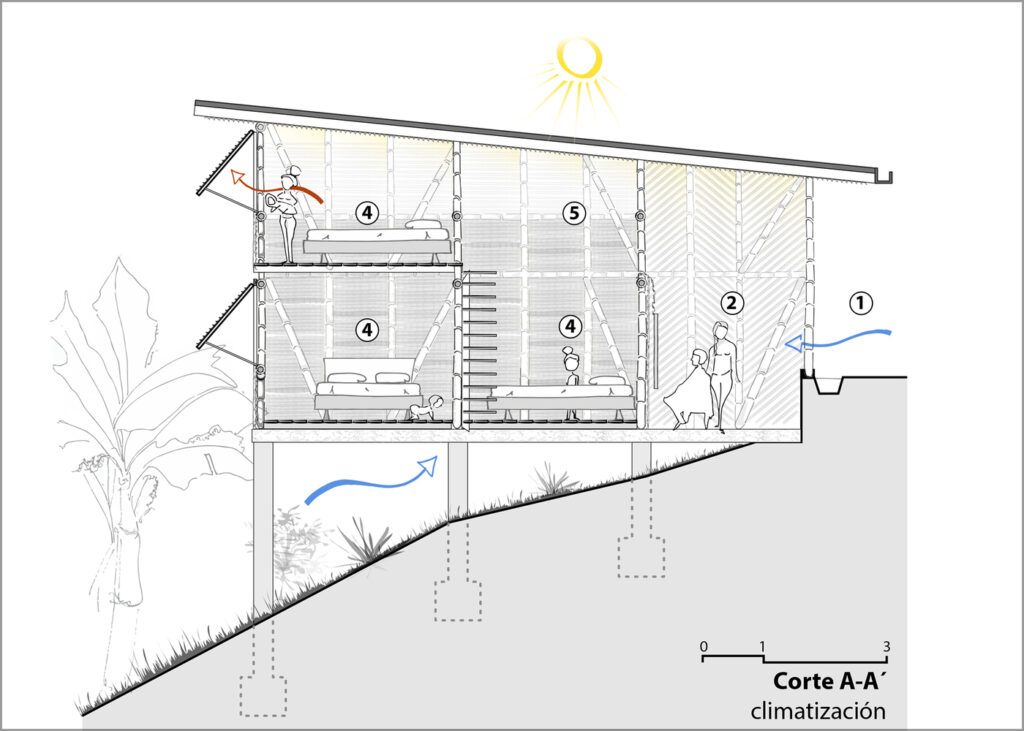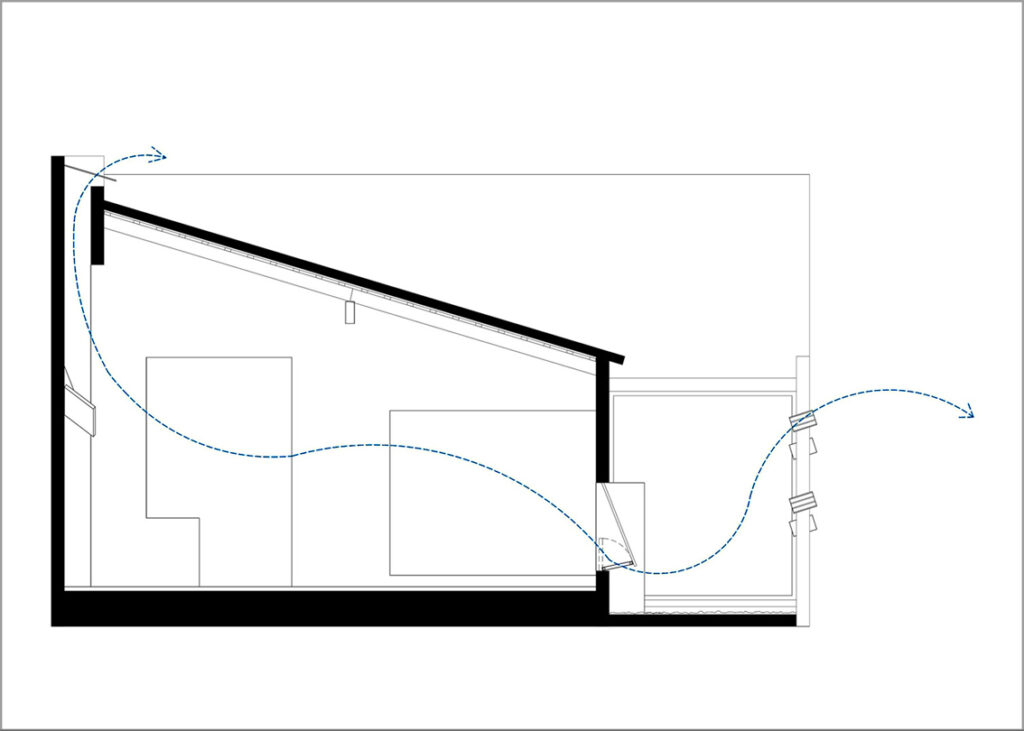
Master the Development of Sustainable Architectural ConceptS
START IN OCTOBER 7th
Introduction to Cross Ventilation
Ever walked into a room and felt instantly refreshed, as if the breeze itself had decided to wind through the space? That’s cross ventilation at work! This natural marvel isn’t just about keeping your home cool; it’s a crafty design principle that architects swear by for sustainable living.
In essence, cross ventilation is about inviting the wind inside. It’s a simple method: air enters through an opening, travels across the room, and exits through another, opposite or adjacent. This not only cools the space but also flushes out stale air and pollutants, ensuring your home breathes just as nature intended.
Why Is Cross Ventilation Crucial?
Cross ventilation isn’t a new fad; it’s an ancient practice that modern homes are revisiting to tackle today’s energy and health challenges. Here’s why it’s making a comeback:
- Healthier indoor air: Keeps the air inside your home fresh and free of unwanted odors and contaminants.
- Energy efficiency: Reduces the need for air conditioning, slashing your energy bills and minimizing your carbon footprint.
- Sustainability: By using natural forces like wind, it decreases the home’s reliance on mechanical systems, aligning with green building practices.
How Cross Ventilation Works

To harness the power of cross ventilation, you need to understand the forces behind it. It’s all about the dance between wind pressure and building design.
The Science of Airflow
Air moves from areas of high pressure to low pressure. When wind hits your building, it creates a higher pressure on the windward side. Openings on this side allow fresh air to enter. As the air moves through the building towards the leeward side (where the pressure is lower), it picks up heat and indoor pollutants. Exiting openings on this side, it takes the unwanted heat and pollutants with it.
Key Factors Affecting Cross Ventilation:
- Wind direction and speed: The primary drivers of natural ventilation.
- Opening placement: Windows and doors should be strategically placed to optimize airflow.
- Interior layout: Obstacles within the home can obstruct airflow, so an open layout works best.
Architectural Considerations
Getting cross ventilation right means thinking carefully about your building’s design. Here’s what matters:
- Orientation: Aligning your home to take advantage of prevailing winds.
- Window types and sizes: Larger and strategically placed windows enhance airflow.
- Thermal mass: Materials that store heat during the day and release it at night can help maintain airflow.
By integrating these elements, your building can effectively harness the wind, transforming a gentle breeze into a powerful tool for natural cooling and ventilation.
Benefits of Cross Ventilation
Cross ventilation isn’t just a technique to make your space feel airy on a warm day—it’s a strategic design choice with a multitude of benefits. Let’s dive into why incorporating it into your building isn’t just smart; it’s essential.
Enhancing Indoor Air Quality
Indoor air quality isn’t merely about comfort; it’s about health. Cross ventilation acts like a natural air purifier:
- Reduces pollutants: By continuously replacing indoor air with fresh outdoor air, it reduces the concentration of indoor pollutants like VOCs, smoke, and mold spores.
- Lowers humidity levels: It helps in keeping the indoor environment less hospitable to allergens such as dust mites and mold.
- Refreshes the air: It sweeps away stale air and odors from cooking, pets, or chemicals.
Energy Efficiency and Sustainability
In a world where energy conservation is paramount, cross ventilation offers an eco-friendly solution:
- Cuts down on AC use: By improving the natural coolness of a space, it reduces the need for air conditioning, leading to significant energy savings.
- Utilizes renewable resources: It relies entirely on natural wind, making it a renewable means of cooling and ventilation.
- Supports sustainable building practices: Integrating cross ventilation aligns with green building certifications and standards, promoting overall sustainability in construction.
Cost-Effective Comfort
The financial implications of integrating cross ventilation are equally impressive:
- Reduces energy bills: Lower dependence on mechanical cooling means lower monthly energy bills.
- Increases property value: Buildings with sustainable features like cross ventilation often attract higher market values.
- Low maintenance: Unlike mechanical systems, natural ventilation systems require minimal upkeep.
Designing for Cross Ventilation
To reap the full benefits of it, it’s crucial to consider how a building is designed. From the drawing board to the doorknob, every element can influence the effectiveness of cross ventilation.
Architectural Elements Essential for Effective Cross Ventilation
Successful cross ventilation starts with thoughtful architectural design. Here are key elements to consider:
- Window placement and size: Strategic placement of windows across from each other ensures maximum airflow. Larger windows can increase air exchange rates.
- Doorways and internal openings: These should facilitate air movement from one room to another, avoiding air traps.
- Roof vents: They can help in expelling hot air that rises and can’t escape through side openings.
Case Studies: Implementations in Various Climates
Understanding how cross ventilation is applied in different settings can provide valuable insights:
- Tropical homes: In hot and humid climates, cross ventilation is used to cool interiors naturally, reducing reliance on energy-intensive air conditioning.
- Temperate climates: Here, it helps in both warming and cooling the home, depending on the season, by managing air flow and internal temperatures naturally.
Each of these implementations showcases the adaptability and universal benefit of cross ventilation, proving its worth across diverse architectural styles and climatic conditions.
Cross Ventilation vs. Mechanical Ventilation
When it comes to ventilating a space, the choice often boils down to natural methods like cross ventilation versus mechanical systems. Here’s how they stack up against each other:
Comparison of Effectiveness
- Natural airflow: Cross ventilation leverages natural wind and pressure differentials to move air through a space, which can be highly effective in areas with consistent breezes.
- Controlled environment: Mechanical ventilation systems, such as HVAC, offer precise control over indoor air quality and temperature, beneficial in climates with extreme weather or little wind.
Cost and Environmental Impact
- Energy savings: Cross ventilation eliminates the need for powered cooling for much of the time, significantly reducing energy consumption.
- Carbon footprint: Mechanical systems consume electricity, contributing to a building’s carbon footprint, whereas cross ventilation has a negligible environmental impact.
Suitability for Different Environments
- Urban settings: Mechanical ventilation might be necessary in densely populated areas where buildings block natural wind flows.
- Rural or coastal areas: Cross ventilation can be highly effective in open environments where buildings can take full advantage of natural winds.
Optimizing Home Layout for Effective Cross Ventilation
Designing a home that maximizes the benefits of cross ventilation requires careful planning and understanding of environmental factors. Here are strategies to ensure that your home is not just built but crafted for optimal airflow.
Strategic Renovation and Construction Tips
- Open floor plans: Minimize internal walls to allow air to flow freely throughout the home.
- Proper alignment of openings: Ensure that windows and doors across from one another are aligned to create a direct air path.
Role of Windows, Doors, and Other Openings
- Windows: Consider larger, operable windows that can be adjusted to regulate airflow. Placing them on opposite or adjacent walls creates a stronger draft.
- Doors: Internal doors with vents or transoms help maintain airflow between rooms, even when closed.
- Skylights and roof vents: These can be used to release hot air that rises, which is especially useful in multi-story buildings.
By integrating these design elements, homeowners and builders can create environments that not only promote health and comfort but also embrace ecological and economic sustainability.
Materials and Technology Enhancing Cross Ventilation
Selecting the right materials and incorporating innovative technologies can significantly boost the effectiveness of this technique. Here’s a look at some advanced options that can help fine-tune the airflow in any building.
Innovative Building Materials
- Breathable walls: Materials like porous bricks and certain plasters allow air to permeate the walls, enhancing overall ventilation.
- Reflective coatings: Applied to exterior surfaces, these can reduce heat absorption, keeping the indoor environment cooler and reducing the thermal load on cross ventilation.
Smart Ventilation Technologies
- Automated windows: Equipped with sensors, these windows can open or close based on the indoor air quality or external weather conditions, optimizing airflow without manual intervention.
- Heat recovery ventilators (HRVs): While primarily used in mechanical ventilation systems, HRVs can be adapted for use in homes with cross ventilation to retain heat during colder months while still refreshing the air.
Common Challenges and Solutions
While it can significantly enhance living spaces, it’s not without its challenges, especially in urban environments or areas with specific climatic conditions. Here’s how to address these issues effectively.
Dealing with Obstructions and Urban Layouts
- Strategic placement of vents: In buildings where direct wind paths are blocked by other structures, placing vents or additional openings strategically can help in capturing and redirecting airflow.
- Use of courtyards or atriums: These can serve as air wells, especially in densely built-up areas, drawing air upwards and promoting ventilation throughout the building.
Pollution and Noise Concerns
- High-quality filters: Integrating filters into openings can help mitigate the intake of pollutants and allergens.
- Soundproofing materials: Using double-glazed windows or specialized insulating materials around openings can reduce the impact of external noise while maintaining air flow.
Adapting to Different Climates
- Adjustable window designs: In areas with variable weather conditions, windows that can adjust their openings based on the weather can maintain optimal ventilation without compromising on comfort or energy efficiency.
- Landscaping for wind protection: Strategic placement of trees and shrubs can shield buildings from harsh winds while funneling cooler breezes towards them.
These solutions highlight the adaptability of cross ventilation strategies, ensuring that regardless of the external challenges, there are ways to maintain a fresh and healthy indoor environment. This section provides practical advice for overcoming the typical hurdles associated with implementing effective natural ventilation, making it a crucial read for anyone facing similar challenges in their building projects.

Regulations and Standards
Navigating the maze of building codes and standards is crucial for architects and builders looking to integrate cross ventilation into their designs. Here’s what you need to know to ensure compliance and optimize performance.
Building Codes and Standards Impacting Design
- Local and international codes: These often dictate the minimum requirements for natural ventilation, including the size and placement of openings.
- Green building certifications: Standards like LEED, BREEAM, and others encourage or even require natural ventilation strategies for certification points.
How Compliance Enhances Building Performance
- Ensures safety and health: Compliance with ventilation standards helps protect occupants from poor air quality and building-related illnesses.
- Boosts energy efficiency: Adhering to standards can lead to designs that maximize energy savings through effective use of natural ventilation.
Future of Cross Ventilation
As we look towards more sustainable building practices, it is set to play a pivotal role. Let’s explore the trends and innovations that are shaping the future of architectural design.
Trends in Architectural Design
- Integrated design approaches: Combining cross ventilation with other sustainable practices like solar shading and passive solar heating to create buildings that are not only energy-efficient but also adaptable to changing climates.
- Smart building technologies: IoT devices and smart home systems are being designed to automatically adjust ventilation based on real-time environmental data.
Innovations in Cross Ventilation
- Advanced simulation software: New tools allow architects to simulate wind flow and air quality within a design long before construction begins, enabling more precise and effective ventilation strategies.
- Enhanced architectural elements: Developments in materials and building technology are leading to more effective ways of managing airflow, such as dynamically adjustable facades that respond to environmental changes.
These insights into the future of this technique underscore its importance in modern architecture and highlight how ongoing advancements in technology and design are making it an even more essential component of sustainable building practices.
FAQs About Cross Ventilation
Addressing common queries can clarify misconceptions and provide practical insights for those interested in incorporating cross ventilation into their spaces. Here are some frequently asked questions and their answers.
Common Questions Explained
- What is the optimal design for cross ventilation in a home?
- The optimal design involves aligning openings like windows and doors directly across from each other to create a straight path for air to flow. This should be supported by an open interior layout that minimizes obstructions.
- Can cross ventilation work in a high-rise building?
- Yes, cross ventilation can be effective in high-rises if designed correctly. This involves strategic placement of operable windows and potentially using architectural features like atriums or vented skylights to assist with upward air movement.
- How does weather affect cross ventilation?
- Adverse weather, like high winds or heavy rains, can impact the effectiveness of cross ventilation. Solutions include adjustable window systems that can reduce openings during such conditions while still allowing for some air exchange.
- Is cross ventilation feasible in all climates?
- While cross ventilation is beneficial in most climates, its design and implementation may vary. For instance, in extremely cold regions, it’s important to balance ventilation with heat retention.
Troubleshooting Tips
- Dealing with too much wind: Use adjustable windows that can be partially closed to moderate the airflow.
- Enhancing airflow in still conditions: Consider using passive ventilators or small mechanical aids like ceiling fans to help move air during periods of little to no wind.
Conclusion
Summarizing the essence and benefits of cross ventilation, this section reinforces its importance and practicality in modern architecture.
Recap of Cross Ventilation Benefits
- Health: Improved air quality and reduced allergens.
- Energy efficiency: Lowered energy costs due to reduced reliance on mechanical cooling systems.
- Sustainability: Enhanced environmental friendliness by utilizing natural resources.
Final Thoughts on Implementing Cross Ventilation
- Architectural integration: It should be considered at the initial design phase to maximize its effectiveness.
- Future readiness: As building standards evolve and focus more on sustainability, incorporating cross ventilation into designs not only meets current standards but also prepares for future regulations.
If you want to learn about our consultancies in Portuguese language, click here.

Master the Development of Sustainable Architectural ConceptS
START IN OCTOBER 7th